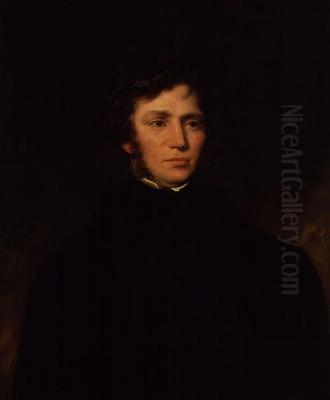
William Clarkson Stanfield stands as one of the most distinguished figures in nineteenth-century British art. Born in Sunderland on December 3, 1793, and passing away in Hampstead on May 18, 1867, Stanfield carved a unique path from the high seas to the highest echelons of the London art world. Renowned primarily for his dramatic and meticulously detailed marine paintings and coastal landscapes, he also achieved considerable fame as a theatrical scene painter early in his career. His work captured the power and beauty of the natural world, particularly the ocean, with a truthfulness born from direct experience, blended with a sense of romantic drama that captivated audiences, including royalty and fellow artists alike.
Early Life and Maritime Beginnings
Stanfield's affinity for the sea was ingrained from his youth. His father, James Field Stanfield, was an Irish author, actor, and notably, a former seaman himself, who had also penned works against the slave trade. His mother was Mary Hoad. This familial connection to both the arts and the maritime world likely shaped young William's future trajectory. Sunderland, his birthplace, was a bustling port town, further immersing him in nautical life.
His direct experience with the sea began in earnest around 1808 when he joined the merchant navy. Life at sea during the Napoleonic Wars was perilous. Stanfield was pressed into service in the Royal Navy, joining HMS Namur. His time aboard naval vessels provided him with invaluable firsthand knowledge of ships, the varying moods of the ocean, and the dramatic interplay of light and weather on water – observations that would later infuse his paintings with remarkable authenticity.
A significant encounter during his seafaring years was with Thomas Clarkson, the prominent abolitionist. Stanfield developed a deep respect and friendship with Clarkson, whose tireless campaigning against the slave trade resonated with him. In honour of this influential figure, William Stanfield later adopted 'Clarkson' as his middle name, becoming William Clarkson Stanfield.
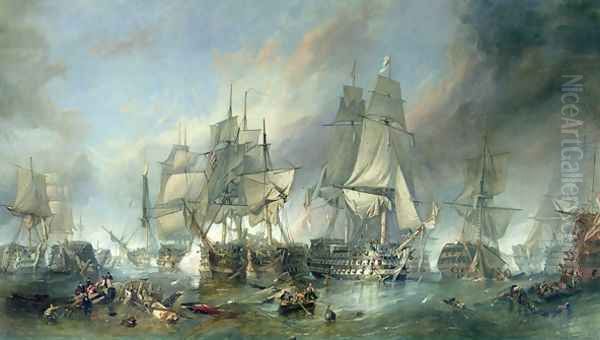
His naval career, however, was cut short. Around 1814 or shortly thereafter, Stanfield suffered a severe fall while on duty, sustaining injuries that rendered him unfit for further service. He was discharged from the Royal Navy, an event that, while seemingly a setback, ultimately redirected him towards his true calling in the world of art.
Transition to Art: The Scene Painter
Following his discharge from the navy, Stanfield initially turned his hand to decorative painting. However, his artistic talents soon found a more dynamic outlet in the burgeoning world of London theatre. He began working as a scene painter, a profession that demanded both technical skill and imaginative flair. His early theatrical work commenced at the Royalty Theatre in East London and later at the Coburg Theatre (now the Old Vic).
His reputation grew rapidly. By the early 1820s, Stanfield had secured a position at the prestigious Theatre Royal, Drury Lane, one of London's leading playhouses. Here, he worked alongside other talented artists, most notably David Roberts, who would also become a celebrated easel painter and a lifelong friend. Together, they created spectacular scenic effects, including vast panoramas and innovative "moving dioramas" – large painted canvases that scrolled across the stage to simulate travel or changing scenes, captivating audiences with their illusionistic depth and drama.
Stanfield excelled in this medium. He designed elaborate sets for numerous productions, including pantomimes, melodramas, and historical spectacles. Plays like Haroun Alraschid (likely based on the Caliph of Bagdad) and popular pantomimes such as Thumbling (Tom Thumb) featured his impressive scenic artistry. This theatrical work honed his skills in composition, perspective, and the dramatic use of light and shadow, techniques that would profoundly influence his later easel paintings. The large scale and need for immediate visual impact inherent in scene painting contributed to the boldness and clarity found in his subsequent work.
Rise to Prominence: The Easel Painter
While achieving success in the theatre, Stanfield simultaneously began developing his career as an easel painter. His deep knowledge of the sea and ships naturally led him to specialize in marine subjects. He started exhibiting his oil paintings and watercolours at prominent venues like the British Institution and the Society of British Artists (SBA) from the early 1820s.
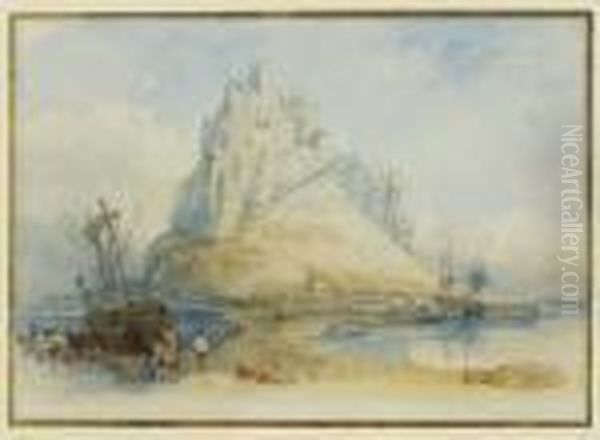
His work quickly gained critical acclaim for its accuracy, detail, and atmospheric power. Unlike some contemporaries whose marine views were more generalized or idealized, Stanfield's paintings possessed an authenticity derived from his years at sea. He understood the construction of ships, the dynamics of wind and waves, and the subtle shifts in weather and light, rendering them with convincing precision.
His success as an easel painter grew steadily. By the late 1820s and early 1830s, the demand for his paintings allowed him to gradually withdraw from the demanding world of theatre scenography. He dedicated himself increasingly to creating finished oil paintings and watercolours intended for exhibition and sale, establishing himself as a leading figure in the British art scene beyond the confines of the stage. His subjects expanded from purely marine views to include coastal landscapes, river scenes, and topographical views from his travels in Britain and continental Europe.
Academic Recognition and Royal Patronage
Stanfield's rising reputation was formally acknowledged by the art establishment. He was instrumental in the formation of the Society of British Artists (SBA) in 1824, serving as its president for a period, demonstrating his commitment to promoting the interests of fellow artists. His work consistently featured in the SBA exhibitions and those of the prestigious Royal Academy of Arts.
In 1832, his achievements were recognized with election as an Associate of the Royal Academy (ARA). Just three years later, in 1835, he was elevated to the status of a full Royal Academician (RA), a mark of high distinction in the British art world. This solidified his position among the leading artists of his generation, alongside figures like J.M.W. Turner, David Wilkie, and his friend David Roberts.
His work also attracted royal attention. King William IV, himself a former naval officer known as the 'Sailor King', particularly admired Stanfield's marine paintings. The King commissioned two significant works: The Opening of New London Bridge (1832), depicting the ceremonial event attended by the King and Queen Adelaide, and Portsmouth Harbour. These commissions significantly boosted Stanfield's prestige. Later, Queen Victoria also became an admirer and patron of his work. His paintings were frequently purchased by aristocratic collectors and the newly wealthy industrialists of the Victorian era.
Artistic Style and Technique
William Clarkson Stanfield's artistic style is characterized by a compelling blend of detailed realism and romantic sensibility, often infused with a dramatic flair inherited from his scene-painting days. His primary strength lay in his profound understanding and accurate depiction of the sea, ships, and coastal topography.
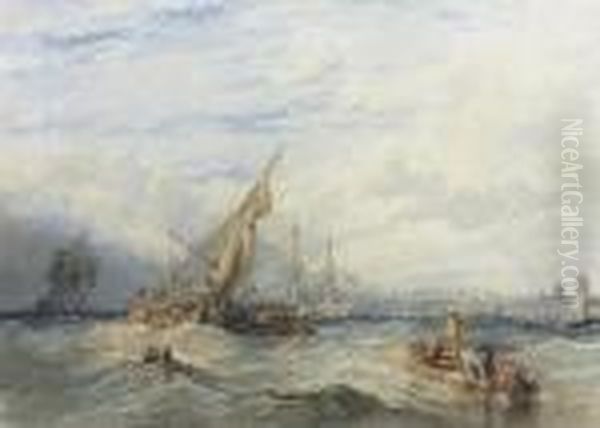
Realism and Accuracy: Grounded in his extensive maritime experience, Stanfield's portrayal of ships was meticulous. He understood their rigging, hulls, and how they behaved in different sea conditions. His seascapes accurately reflected the effects of weather – the transparency of calm water, the turbulence of storms, the quality of light on waves. This commitment to truthfulness earned him praise from critics like John Ruskin, who initially valued Stanfield's perceived accuracy even above the more imaginative renderings of J.M.W. Turner, though Ruskin's views evolved over time.
Dramatic and Theatrical Flair: His background in theatre instilled a sense of drama in his compositions. Even in tranquil scenes, there is often a dynamic arrangement of elements, skillful use of perspective, and attention to atmospheric effects that create visual interest and emotional resonance. In storm scenes or historical subjects like The Battle of Trafalgar, this theatricality becomes overt, emphasizing the power and spectacle of the event.
Mastery of Light and Colour: Stanfield possessed a keen eye for the effects of light on water and landscape. His palettes were often characterized by clear, luminous colours. He masterfully rendered the interplay of sunlight and shadow, the reflections on water surfaces, and the subtle gradations of tone in skies and seas. His handling of light contributed significantly to the sense of realism and atmosphere in his work.
Romantic Sensibilities: While grounded in observation, Stanfield's work was not merely documentary. He infused his scenes with mood and emotion, aligning with the broader Romantic movement's interest in the sublime power of nature. His shipwrecks evoke awe and pity, his coastal views often possess a serene or melancholic beauty, and his historical paintings capture moments of national pride or dramatic conflict. He balanced topographical accuracy with an artistic interpretation that elevated the scene beyond simple representation.
Versatility: Although best known as a marine painter, Stanfield was remarkably versatile. He painted landscapes across Britain, including Scotland and Cornwall, and undertook several tours of continental Europe, producing numerous views of Italy (especially Venice), France, the Netherlands, and Germany. His topographical works, such as the lithographs published in Sketches on the Moselle, the Rhine, and the Meuse (1838), were highly popular and demonstrated his skill in capturing the specific character of different locations.
Major Works and Themes
Stanfield's prolific output includes many celebrated paintings that exemplify his style and thematic concerns.
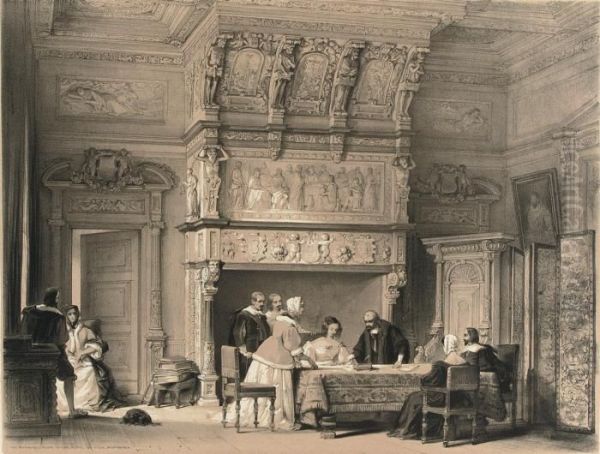
The Battle of Trafalgar (commissioned 1836): Painted for the United Service Club in London, this large-scale work is one of his most famous. It depicts the climax of Nelson's victory, showcasing Stanfield's ability to handle complex historical subjects with naval accuracy and dramatic intensity. The chaos of battle, the detailed rendering of the warships, and the atmospheric effects of smoke and sea combine to create a powerful image of naval warfare.
St Michael's Mount, Cornwall (exhibited RA 1830): Considered one of his masterpieces of British coastal scenery. The painting captures the iconic tidal island with its castle bathed in dramatic light, set against a dynamic sea and sky. It perfectly illustrates his ability to combine topographical accuracy with romantic atmosphere.
Portsmouth Harbour (c. 1833): Commissioned by William IV, this work, along with The Opening of New London Bridge, cemented his reputation with royal patronage. It presents a detailed panorama of the busy naval port, filled with accurately rendered ships and bustling activity, showcasing both his marine expertise and his skill in topographical depiction.
Venetian Views: Like many artists of his time, Stanfield was captivated by Venice. He painted numerous scenes of the city's canals, palaces, and lagoons, often focusing on the interplay of light, water, and architecture. These works were highly popular with collectors and demonstrate his versatility beyond purely British subjects. Notable contemporaries like James Holland also specialized in Venetian scenes.
Coastal and River Scenes: Stanfield produced a vast number of paintings depicting the coasts and rivers of Britain and Europe. These range from tranquil estuary scenes to dramatic depictions of ships battling storms off rocky shores. Works like The Abandoned (1856), showing a derelict ship foundering in heavy seas, highlight his interest in the power and danger of the ocean.
Sketches on the Moselle, the Rhine, and the Meuse (1838): This published volume of lithographs based on his travel sketches brought his work to a wider audience. It showcased his talent for capturing the picturesque qualities of continental landscapes and architecture, further enhancing his reputation as a versatile topographical artist.
The Wreck of the 'Elgin' (or similar wreck scenes): While the specific title 'Elgin' might be less prominent than others, Stanfield frequently painted shipwreck scenes, a popular theme in Romantic art. These works, such as the well-documented Wreck of the Avenger off the coast of North Africa, allowed him to explore themes of human struggle against the overwhelming forces of nature, showcasing his mastery in depicting tumultuous seas and dramatic events.
Contemporaries and Collaborations
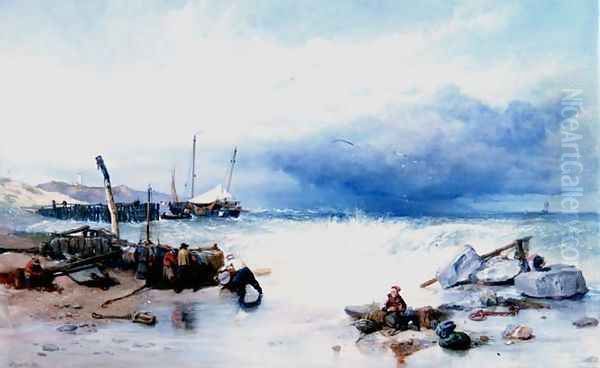
Stanfield operated within a vibrant London art world, interacting with many leading figures of the era.
David Roberts (1796-1864): Perhaps his closest artistic associate, Roberts shared Stanfield's background in scene painting and rose to fame as an easel painter, specializing in architectural and landscape views, particularly of the Near East. They worked together at Drury Lane and remained lifelong friends, both becoming prominent Royal Academicians.
J.M.W. Turner (1775-1851): The towering figure of British Romantic landscape and marine painting. While Stanfield admired Turner, his own style emphasized greater clarity and topographical accuracy compared to Turner's more abstract and visionary approach to light and colour. Critics like Ruskin often compared the two, initially favouring Stanfield's 'truthfulness'.
Edward William Cooke (1811-1880): A younger contemporary and friend, Cooke also specialized in marine painting, sharing Stanfield's interest in accurate ship portrayal and coastal scenery. Both were elected RAs and moved in similar artistic circles. Augustus Wall Callcott (1779-1844) was another significant marine painter of the slightly older generation.
Charles Dickens (1812-1870) and the Literary Circle: Stanfield enjoyed a close friendship with the novelist Charles Dickens. He was part of Dickens's circle, which included writers and artists involved in amateur theatrical productions organized by Dickens. Stanfield often designed and painted scenery for these private plays. Other artists in this circle included Daniel Maclise (1806-1870), John Leech (1817-1864), and Frank Stone (1800-1859). Dickens deeply admired Stanfield's work, sometimes referencing it in his writings.
Other Royal Academicians: As a prominent RA, Stanfield would have regularly interacted with other leading artists of the day, such as the President Sir Charles Lock Eastlake (1793-1865), the celebrated animal painter Sir Edwin Landseer (1802-1873), and the influential genre and historical painter Sir David Wilkie (1785-1841). He was part of the establishment, exhibiting alongside them and participating in the Academy's affairs. John Constable (1776-1837), the great landscape painter, was an older contemporary whose focus on naturalism paralleled Stanfield's own commitment to observation, albeit in different subject matter.
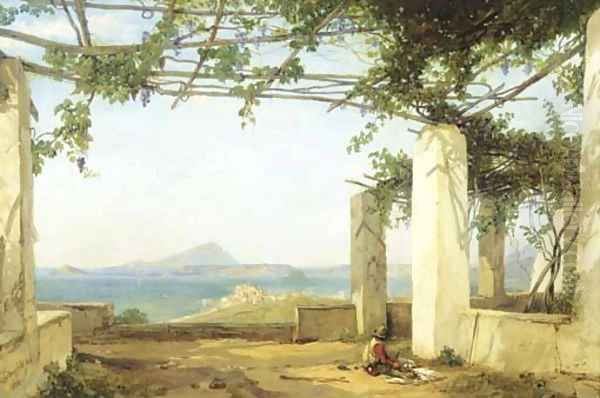
George Clarkson Stanfield (1828-1878): His son, George, followed in his father's footsteps, becoming a painter specializing in landscapes and marine views, particularly continental river and coastal scenes. While talented, he never quite achieved the same level of fame as his father. Confusion sometimes arises between their works due to the shared name and similar subject matter.
Later Life and Legacy
William Clarkson Stanfield spent his later years residing in Hampstead, then a village on the outskirts of London favoured by artists and writers. He continued to paint prolifically, exhibiting regularly at the Royal Academy almost until his death, despite suffering from ill health, including rheumatism and persistent leg pain, in his final years.
He passed away at his home, The Green-hill in Hampstead, on May 18, 1867. His death was widely mourned, and his funeral procession was attended by many prominent figures from the art world. He was buried in Kensal Green Cemetery, London, a common resting place for notable Victorians. His former Hampstead residence later became part of the local library system, preserving a connection to his time there.
Stanfield's legacy is significant. He is consistently regarded as one of the foremost British marine painters of the nineteenth century. His work successfully bridged the gap between the detailed topographical tradition and the dramatic impulses of Romanticism. His paintings were admired for their technical skill, their authentic portrayal of the sea and ships, and their atmospheric power.
His influence extended through his numerous pupils and followers, and his work set a standard for marine painting that persisted through much of the Victorian era. His paintings continue to be held in high regard and are found in major public collections, including the Victoria and Albert Museum, the National Maritime Museum in Greenwich, the Tate Britain, and numerous regional galleries throughout the UK and abroad. His life story, from sailor to celebrated artist and Royal Academician, remains a compelling narrative of talent and perseverance.
Conclusion
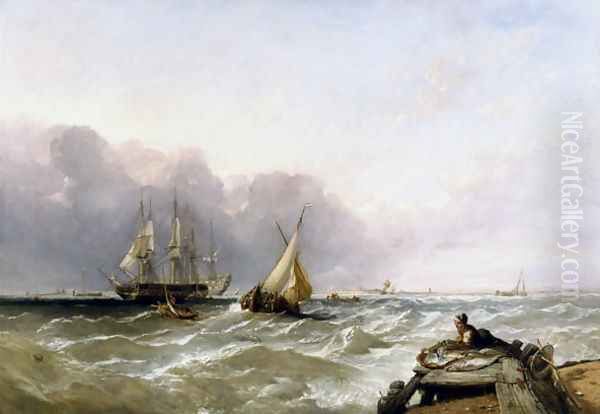
William Clarkson Stanfield's journey from the decks of naval ships to the galleries of the Royal Academy is a testament to his exceptional talent and dedication. His deep, experiential understanding of the maritime world, combined with skills honed in the demanding craft of scene painting, allowed him to create marine and landscape paintings of enduring power and appeal. He captured the beauty, drama, and specific character of the sea, coasts, and cities he depicted with a unique blend of accuracy and artistic sensibility. Through his prolific output, his influence on contemporaries, and his engagement with the cultural life of his time, Stanfield secured a lasting place as a master of the marine view and a key figure in the rich tapestry of British Victorian art.